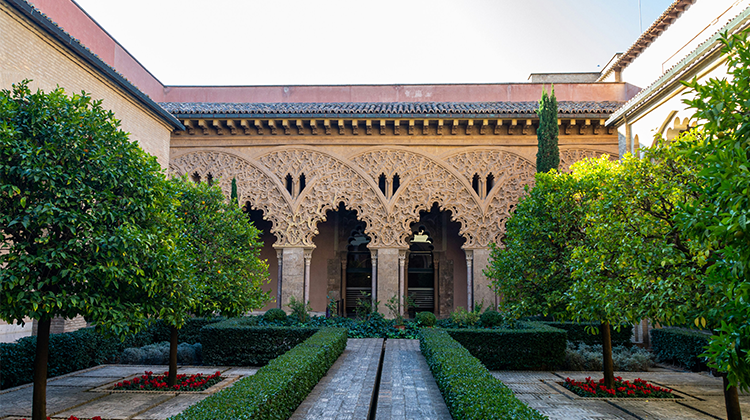There was a time when the Christian kingdoms, Muslim Spain and the Jews, who were already in Spain before the arrival of Islam, coexisted in the same space. While a new emirate, Al-Andalus, appeared in the south, Christian Spain became strong in the north. Both conquests and reconquests forged the character of what we call Spain today, with the inevitable fusion of cultures and languages, which has lasted to this day. As it could not be otherwise, its resulting cultural, gastronomic and architectural appeal has crossed borders, sometimes in an unusual way.
GIUSEPPE VERDI AND THE KINGDOMS OF TAIFAS IN SPAIN
Little did Abú Jaáfar Áhmad Ibn Sulaymán al-Muqtádir billah imagine that his dreamed summer palace in Zaragoza would be, 800 years later, the inspiration and perfect setting for one of the most famous operas in the world.
The king of the taifa of Saraqusta - better known as Al-Muqtádir, to simplify the language - devised the construction of a summer residential palace that would show the splendour and power of his Taifa. Its beauty would be such that he himself referred to it as his palace of La Alegría-happiness- (nowadays palace of Aljafería). Saraqusta was more than the current Zaragoza province, as it included a large part of the Mediterranean territories.
At the hands of its architect, Al-Halifa Zuhayr, at the beginning of the 11th century, work began around an existing observation tower. On the outskirts of the Muslim city and surrounded by orchards, the palace stood. A large open patio surrounded by rooms decorated with coffered ceilings and plasterwork on the walls and ceilings, which surely made the torrid summer nights a little more bearable.
In January 1853, spectators at the Apollo Theater in Rome met a troubadour who night after night visited his beloved at the foot of a tower and witnessed their dramatic love story. Giuseppe Verdi premiered his opera Il Trovatore, and the keep tower of the Aljafería palace became the Troubadour tower. It was in that tower where the plot of the work by Antonio García Gutiérrez takes place, which served as inspiration for the libretto of the opera Il Trovatore, by Giuseppe Verdi.
There are many stories and transformations that this palace underwent throughout those 800 years, passing from the hands of Muslim kings to Christian kings, a witness to Napoleonic wars, or even as a prison for the Inquisition. The common sense of humans perhaps saved this monument, or as with music, it was the beauty of art.
Despite its historical transformations, it is the best-preserved Islamic palace from the Taifa era. The Aljafería palace in Zaragoza, together with the Alhambra in Granada and the mosque in Córdoba, is the most precious legacy of Hispano-Muslim art from Al-Andalus in Spain.
WORDS OF ARABIC ORIGIN
At the beginning of the 11th century the population of what we currently know as Spain consisted of local Arabs and Hispano-Romans, so the Hispanic Arab language, of the former, coexisted with the Mozarabic language, of the latter. Just as the art of these aforementioned monuments has fortunately reached our days, there are also many words that came with them (more than 4,000 words, according to the study of philologist Rafael Lapesa).
The Arabs inhabited a large part of the Iberian Peninsula for centuries, while the Spanish language was being formed in Castile, influenced, to a large extent, by the Arabic language.
Here we will review some of them by semantic fields:
AGRICULTURE:
Aceite – oil
Alcachofa – artichoke
Berenjena - eggplant
KNOWLEDGE AND SCIENCE:
Álgebra – algebra
Algoritmo - algorithm
Cifra – cipher
Jarave - syrup
WAR:
Tambor – drum
Alcázar – fortress
Atalaya - watchtower
TRADES:
Alcalde – mayor
Albañil – bricklayer
Alfarero - potter
TOPONYMS:
Many cities owe their name: Algeciras, Almería, Andalusia, Guadalquivir, Guadalajara, Benicasim, Benidorm.
The prefix AL corresponds to our article EL. GUADA would be RIVER. BEN means SON OF.
And of course, the widely used word OJALÁ, from the Spanish Arabic law šá lláh, God willing, which today denotes a strong desire for something to happen.
-Ojalá fuéramos capaces de vivir juntos en paz.
-I wish we were able to live together in peace.
Unfortunately, there are many who think that multiculturalism is subtractive, but it is more than evident that the more fused we are, the greater we will be. Growth can only be understood through the union of peoples, cultures and languages. As Ana Belén and Victor Manuel sang, two classics of Spanish music:
Contamíname
Pero no con humo
Que asfixia el aire
Ven, pero sí con tus ojos y con tus bailes
Ven, pero no con la rabia y los malos sueños
Ven, pero sí con los labios que anuncian besos
Contamíname, mézclate conmigo
Que bajo mi rama
Tendrás abrigo
contaminate me
But not with smoke
that suffocates the air
Come, but yes with your eyes and with your dances
Come, but not with anger and bad dreams
Come, but yes with lips that announce kisses
Contaminate me, mix with me
that under my branch
You will have shelter







